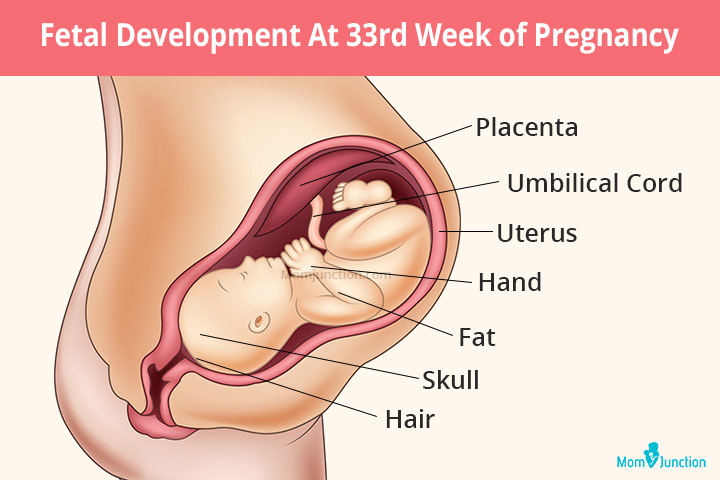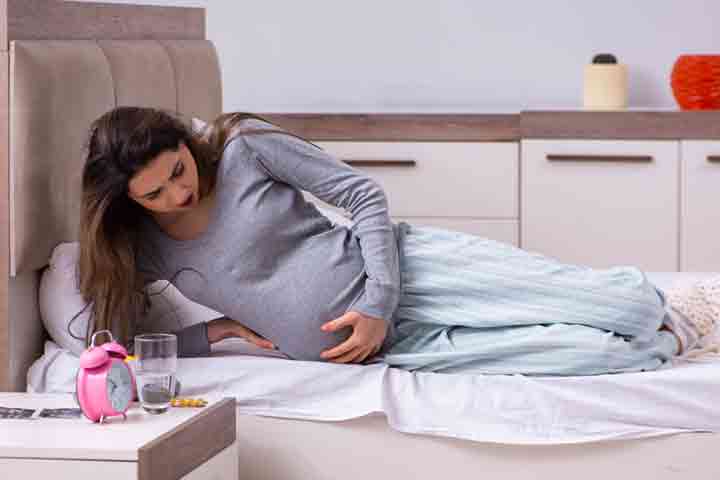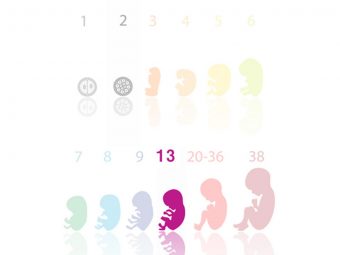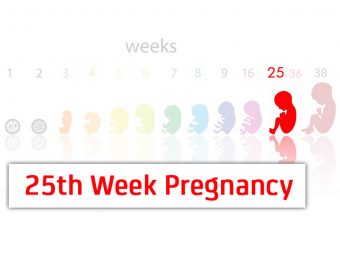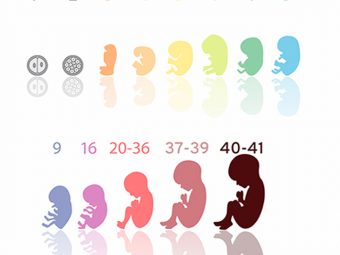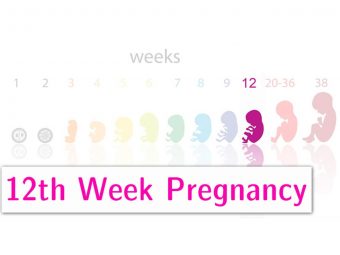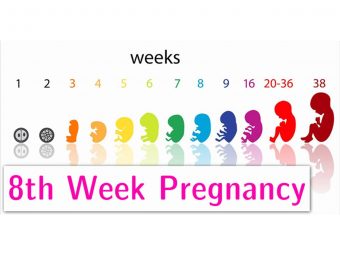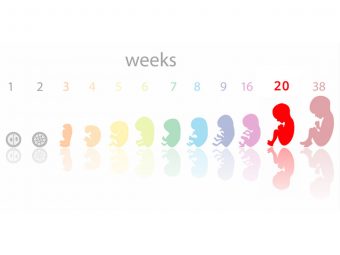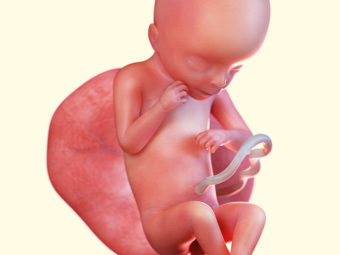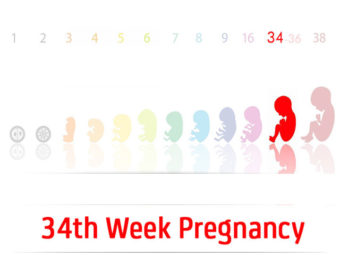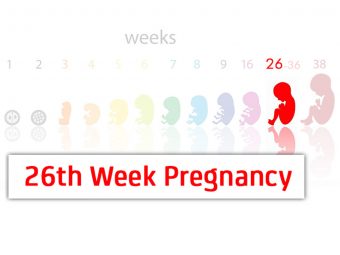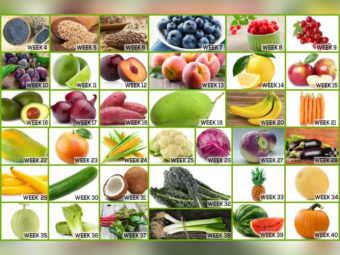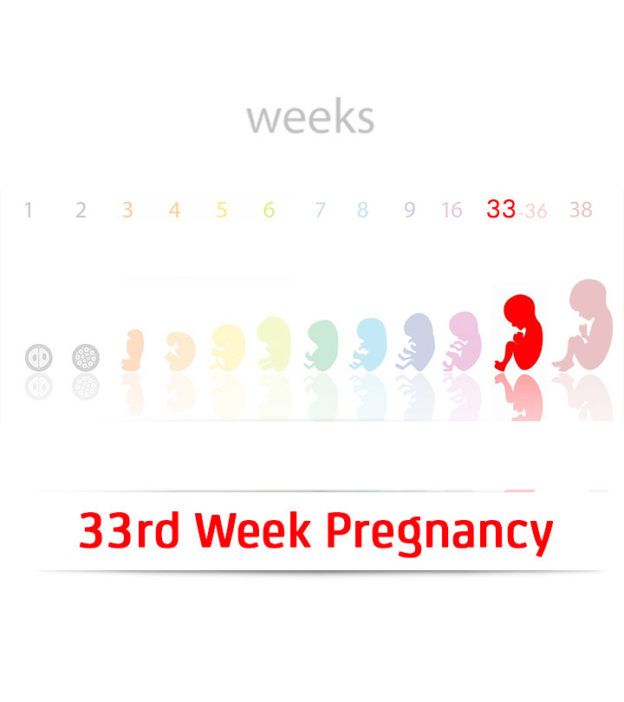
Image: Shutterstock
How Many Months Pregnant Are You At 33 Weeks?
At the 33rd week of pregnancy, you are about seven months and one week pregnant, which means you are in the eighth month of pregnancy.
How Big Is Your Baby At 33 weeks?
In this week, your baby is the size of a pineapple(1).The baby will measure 17.2in (43.7cm) in length and weighs 4.23lb (1.92kg)(2).
Baby Development At 33 Weeks
By this week, the baby gets into a head down position and begins to press down into the cervix. Read on to know how the baby has developed so far.
| Body parts | Development stage |
|---|---|
| Eyes | The baby can open and close the eyes. Pupils can constrict and dilate in response to light. |
| Skin(3) | Thicker and less wrinkled. Fat continues to deposit beneath the skin layer. |
| Lungs(4)(5) | Are almost fully matured. Rhythmic breathing begins. |
| Brain and nervous system(6) | Fully developed. |
| Bones | Starts to harden, but the skull bones remain soft. |
| Limbs | Fully developed with legs curled up towards the chest. |
| Genitals | In boys, testicles descend into the scrotum. |
| Reflexes | The baby can feel, listen and see a little bit. |
The fetal or baby movements slow down by this week of pregnancy as there isn’t enough space inside the womb. As a result, the kick count will also be less this week, ideally around ten kicks in two hours. If you notice a significant drop in the number of kicks, tell your doctor about it.
The symptoms you have been experiencing in the past few weeks will persist this week as well. More about it next.
 Did you know?
Did you know?Symptoms Of Pregnancy At 33 Weeks
Here are the symptoms you may experience during the 33rd week of pregnancy:
- Weight gain:Weight gain should be as per your BMI(7).
| BMI | Below 18.5 | 18.5 – 24.9 | 25 – 29.9 | 30 and Above |
|---|---|---|---|---|
| Weight gain | 21-31lb | 19-27lb | 11.5-20lb | 8-16lb |
- As the body works extra to support the pregnancy, your metabolic rate gets higher and extraheatis generated in the body.
- Stress, dehydration, and hormonal balances can cause aheadache.
- You could experienceshortness of breathdue to the pressure exerted by the enlarged uterus on the diaphragm.
- Lack of sleep or sleep deprivation, stress, and anxiety can cause forgetfulness, a phenomenon calledpregnancy brain.
- The extra weight of the baby puts pressure on the lower back and causes back pain.Using hot and cold compress or taking a bath in warm water can help alleviate the back pain.
- Sciatica, which is an excruciating pain felt in the back and down in the back of the legs, is common when the growing uterus puts pressure on the sciatic nerves.
Image: Shutterstock
- The ankles and feet swell due to water retention in the body, also referred to asedema.
- Body aches and cramps make sleeping difficult during this time, resulting ininsomnia.
- You could becomeclumsydue to the change in the center of gravity of your body.
- The enlarged uterus pushes the stomach upward, causing the gastric acids to move into the esophagus that leads toheartburn.
- Braxton-Hicks contractionsare less painful and irregular contractions that help the body prepare for labor.
- The loosening of abdominal muscles and ligaments causeround ligament pain.
- Pregnancy hormones can make thenails grow fasterandbecome brittle. Increasing your biotin intake can help prevent such changes in the nails.
- The excess blood flow to the lower part of the body can cause swelling of the blood vessels in the legs, a condition calledvaricose veins.
- 增加血液流向肛门的原因hemorrhoids, which is the swelling of the blood vessels.
- Carpal tunnel syndromeis the tingling or numbness in your fingers and wrists. Wearing a hand brace can help relieve the discomfort.
- Frequent urinationis common due to the pressure exerted by the enlarged uterus on the bladder.
Apart from these symptoms, you will continue to experience bodily changes this week.
 Quick fact
Quick factChanges In The Body At 33 Weeks
The physical and emotional changes you might notice during this week include:
Physical changes:
- Enlarged abdomenfrom the enlarged uterus
Image: Shutterstock
- Theareola becomes darkerand starts leaking colostrum in preparation for breastfeeding.
- The abdomen stretches further, causing stretch marks, and becomes more sensitive and itchy.Applying a moisturizer can help relieve theitchiness of the bellyto some extent.
Emotional changes:
- Theanxietylevel will be higher with increasing thoughts aboutlabor painand delivery.
- The hormonal fluctuations will make youmoodyand take a toll on your mental health.
- You developnesting instinctsand start preparations for welcoming the new member.
Since you are nearing the due date, chances of preterm labor exist this week.
Preterm Labor At 33 Weeks Of Pregnancy
Labor before37 weeks of pregnancyis termed preterm. Some of the signs of preterm labor include(8):
- Menstrual-like cramps
- Abdominal pain
- Lower backache
- Change in vaginal discharge (pink or bloody in color)
- Vaginal fluid leak
- Pelvic pressure
- Uterine contractions (five or more in one hour)
If you have more than five contractions in an hour or the time between the contractions is less than 10 minutes, then:
- Keep your bladder empty
- Drink a lot of fluids
- Lie on the left side for an hour and check the timing of the contraction.
If the contractions persist, then call your doctor right away as it may be an indication of preterm labor.
Image: Shutterstock
Your Ob/Gyn Visit
During this week’s prenatal check-up, the doctor will check for:
- Weight
- Blood pressure
- Fundal height
You also need to get anultrasound scan.
In the case of twin pregnancy, there will be frequent visits to the doctor as they need to monitor the babies closely. The doctor will focus on your diet and nutrition and tell you about the ideal weight gain. As there is also a risk of gestational diabetes, high blood pressure and anemia in multiple pregnancies, the doctor monitors your health condition on a regular basis.
Healthy regimes should not be overlooked even as you are nearing your due date. You should practice healthy habits for a healthy baby and a speedy recovery postpartum.
Tips For Mom-to-be
- Avoid standing for long to prevent fatigue.
- Avoid lying on the back.
- Drink a lot of water to stay hydrated.
- Stay calm and relaxed.
- 遵循健康的饮食,吃些家常菜。有smaller meals at regular intervals to deal with pregnancy cravings and eat fiber-rich foods such as plums and apricots.
- Continue taking your prenatal vitamins.
- Avoid lifting heavy objects.
- Engage in regular and moderate exercises like walking. Practice Kegel exercises to strengthen the pelvic floor muscles.
Image: Shutterstock
- Wear loose, comfortable maternity clothes.
- Get lots of rest.
- Plan your maternity leave.
- Read pregnancy or parenting-related books to prepare for the baby’s arrival.
- Search through baby names that you and your partner like.
- Enroll in childbirth classes.
- Do shopping for yourself and get essential baby gear for the newborn.
- Start packing your maternity bag and ensure that you also have everything for diaper changes once the baby arrives.
- Spend quality time with friends and family.
- Plan for hosting a baby shower around this week.
- Prepare a baby registry to help family and friends know what items you need and want for your new baby.
Frequently Asked Questions
1. Why is my belly so hard at 33 weeks pregnant?
As your baby grows, your abdominal wall stretches, making your belly feel firm. However, if you are in your second and third trimester, the occasional tightening or hardening of the belly could be due to Braxton Hicks contractions (false contractions). These less painful and irregular contractions prepare your body for labor and delivery(9).
2. How long do babies sleep in the womb at 33 weeks of pregnancy?
From around 22 weeks, babies start developing a sleeping pattern in the womb. Studies suggest that later in pregnancy, babies spend almost 90 to 95 percent of their time sleeping(10)(11).
3. Can I give birth to twins at 33 weeks?
Childbirth post 37 weeks of pregnancy is considered full-term pregnancy. Usually, the average gestational age at the time of delivery for a twin pregnancy is 35 weeks. However, depending on several factors, such as maternal and fetal health, mothers can deliver twins at 33 weeks(12). Babies born this early would need extra medical care for better health outcomes.
33 rd-week怀孕有宝宝占领铁道部e space in your tummy as the fetus is almost fully developed. You are in the eighth month of gestation, just a few weeks away from holding your bundle of joy. Increased pressure on other organs, causing heartburn, difficulty breathing, frequent urination, edema, and back pain are symptoms of this week. You may feel moody and lethargic due to all the discomfort. However, you should take care of yourself and report to your doctor for any unusual symptoms that may indicate preterm labor or other complications.
Key Takeaways
- At 33 weeks, the baby is the size of a pineapple and is in a head-down position, pressing down on the cervix.
- The baby’s development at this stage includes the ability to open and close their eyes, almost fully mature lungs, and a fully developed brain and nervous system.
- The mother may experience symptoms such as weight gain, a high metabolic rate, headaches, and shortness of breath.
- The mother’s body undergoes drastic changes at 33 weeks, including an enlarged abdomen leading to stretch marks, darker areola, and mood swings.
- Regular prenatal checkups are necessary for monitoring weight, blood pressure, and fundal height.
- During this time, it’s important to avoid standing for long periods, stay calm and relaxed, stay hydrated, engage in moderate exercise, and get plenty of rest.
References:
- Week by Week Fetus Size Demonstrated by Fruits; EPAOA
https://www.epaoa.org/blog/post/5820a32ad5cc8-week-by-week-fetus-size-demonstrated-by-fruits - Hill M; Embryology Fetal Development; UNSW Embroylogy 2018
https://embryology.med.unsw.edu.au/embryology/index.php/Fetal_Development - Pregnancy calendar Week 33; Nutricia
https://www.cgbabyclub.co.uk/article/33-weeks-pregnant - Pregnancy calendar Week 33; KidsHealth
https://kidshealth.org/en/parents/week33.html - Fetal development; US National Library of Medicine
https://medlineplus.gov/ency/article/002398.htm - You and your baby at 33 weeks pregnant; NHS
https://www.nhs.uk/pregnancy/week-by-week/28-to-40-plus/33-weeks/ - Weight Gain During Pregnancy; Utah Department of Health
http://www.babyyourbaby.org/pregnancy/during-pregnancy/weight-gain.php#Weightcharts - Premature Labor; Sutter Health
http://www.babies.sutterhealth.org/during/preg_prematurelabor.html#Risk - What Causes My Belly to Feel Hard and Tight?; Lamaze International
https://www.lamaze.org/Giving-Birth-with-Confidence/GBWC-Post/what-causes-my-belly-to-feel-hard-and-tight - You and your baby at 22 weeks pregnant; NHS
https://www.nhs.uk/pregnancy/week-by-week/13-to-27/22-weeks/ - Adrián Poblano et al.; Neurophysiologic Measurement of Continuity in the Sleep of Fetuses during the Last Week of Pregnancy and in Newborns; NCBI
https://www.ncbi.nlm.nih.gov/pmc/articles/PMC2140151/ - 33 weeks pregnant
https://raisingchildren.net.au/pregnancy/week-by-week/third-trimester/33-weeks - Week-by-week guide to pregnancy
https://www.nhs.uk/start4life/pregnancy/week-by-week/3rd-trimester/week-33/



